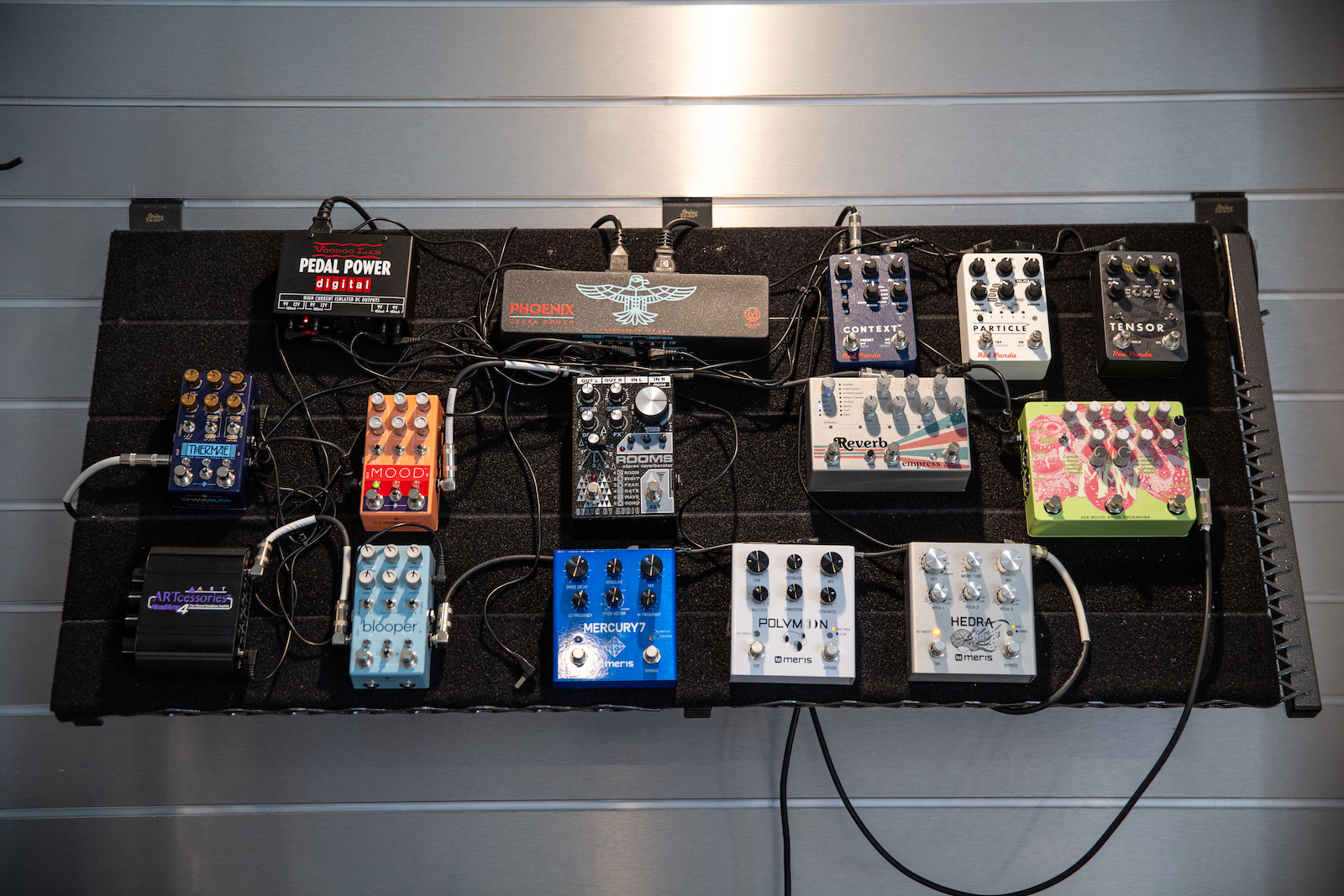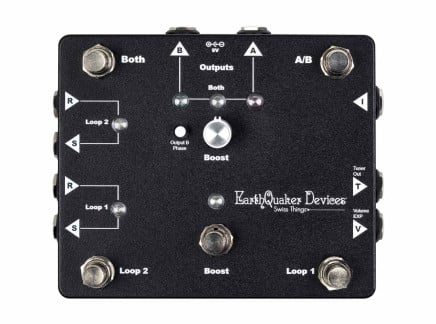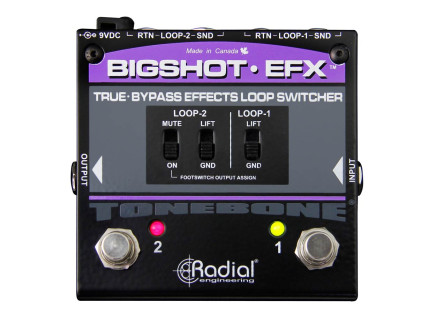There are a lot of ongoing debates in the guitar world. Single coil or humbucker pickups? Germanium or silicon transistors? The buffered bypass vs. true bypass debate is no different.
Some players will swear by the uncolored sound quality of an all-true-bypass pedal chain. Some insist that buffers are what keep your sound intact through multiple pedals, even if it does add a little "tone suck" (more on that later). And middle-of-the-aisle players will agree that it’s helpful to mix it up and have a few of each on their pedalboard.
Let’s go over the differences between buffered and true bypass circuits, the advantages and disadvantages between them, and some things to keep in mind when you’re building out your pedal chain.
What is a Buffer?
Think of a buffer as a preamp built into the circuit. They’re most commonly talked about in the guitar pedal world, but all kinds of audio gear use them. An acoustic guitar with an onboard preamp has a buffer. Active basses have a buffer. Inputs on audio interfaces use buffers.
There are a seemingly endless amount of ways a guitar player can design their rig. Some want everything on the floor, sitting between the guitar and amp. Some need long cable runs for larger environments and more freedom, and some are splitting the signal out to multiple amps.
Without a buffer, every time you add another pedal or pedal connector cabling, more noise gets into your signal. Guitar pickups are especially susceptible to…picking up…noise because of their high impedance. Noise can come from all directions from devices from lighting, to computer monitors, to power cables and more.
The quality of the buffer is one of the most important things to consider. Almost all pedal manufacturers use an IC chip for their input/output stage buffers. They’re affordable, quiet, small, and efficient, all things that make them perfect for pedals. But they don’t all sound the same. A dedicated guitar buffer is optimized for the purpose. They’re more expensive, but if you need one it can be a lifesaver for your tone.
A Class A buffer uses just one amplifier, but they draw a lot of power. And unless they’re really well designed they can add noise. Class B buffers divide the signal into halves, with the positive and negative sides amplified individually and then combined at the output. But they don’t introduce any intermodulation or phase distortion to the signal, the types of distortion that don’t sound good!
A 10 ft. guitar cable will offer a higher sound quality, and you’ll start to notice it around 20 ft. or more of cable length. But 10 ft. isn’t much, even if you don’t move around a lot. Factor in the cables connecting pedals and the overall cable length starts to add up.
What Does a Bypass in a Guitar Pedal Do?
It gets more attention than it rightfully should, but bypass in a guitar pedal is a simple concept. It refers to how the signal is routed when the effect is not engaged. True bypass routes the signal around the circuit when it’s not engaged. Buffered bypass sends it through the circuit at all times.
There are advantages and disadvantages to both. Let’s dive into each specifically so you can discover which might be best for you.
What is True Bypass?
True bypass guitar pedals really caught on with the wave of boutique effects pedal manufacturers that started popping up a few decades ago. While the idea has been around forever, many of the bigger names like BOSS opt to make most, or all, of their pedals buffered bypass (more on what that means in a moment).
When the pedal is in bypass (off) mode, true bypass circuits treat the signal like it’s not even going through the pedal. If you consider a setup of a guitar into an overdrive and then into the front end of an amp, this type of connection takes the pedal circuit out of the equation when it’s disengaged.
If you want to keep your signal as clean as possible but have a few buffered pedals you can’t live without, consider using a loop selector like the Radial Engineering BigShot EFX.
Advantages of True Bypass Pedals
- Great if you have a small signal chain or only use a few pedals without much cabling.
- Retains more of the core tone and interaction between guitar and amp.
- The circuit is taken out of the signal if it’s disengaged.
Disadvantages of True Bypass Pedals
- When you turn a pedal on or off it sends a transient “pop” that can be loud and irritating.
- They usually have switching noise, and using a really distorted, high gain sound makes it stand out more.
- Cable length and quality becomes more important. Longer cable runs introduce more and more tone loss as they get longer.
True bypass pedals have their place, but they also come with a lot of baggage requirements that can affect your tone in significant ways.
What is Buffered Bypass?
Buffered bypass offers a number of advantages. You can chain more pedals together without worrying about tone suck from capacitance, you don’t have to worry about cable length, and if you’re not using too many, the difference in tone is negligible. Ever wonder how so many great guitarists use long and complex pedal chains, but still sound amazing? Buffers make this possible.
Advantages of Buffered Bypass Pedals
- No or greatly reduced switching noise.
- For time-based effects like reverbs and delays, a buffer on the input drives the signal to make the effect work properly.
- Amp response isn’t usually affected significantly.
- You don’t have to worry about the length of cable runs.
- Reduced capacitance or “tone suck” of high frequencies.
Disadvantages of Buffered Bypass Pedals
- Quality of buffer can make or break the tone.
- How your playing interacts with your amp response can be altered, especially if there are multiple buffers in the chain.
- Some pedals only come with buffered bypass, so you’ll have to use a true bypass looper as a workaround.
Overall there’s really not any disadvantage to integrating pedals with buffered bypass into your rig. Even if it’s just one pedal, the benefits generally outweigh the drawbacks.
What is Tone Suck?

Now that we’ve gone over the differences between true and buffered bypass, let’s discuss the real reason for most of the debate between them, what’s lovingly referred to as "tone suck."
If you’re using an unbalanced instrument cable run at a length of more than 20 feet altogether, it introduces what’s called "tone suck"—or in more scientific terms, a sonic result of the accumulated capacitance in your signal path. This alters the tone, cutting off high end and making it sound duller. It also allows more noise to get into the signal.
This compounded loss of high end in the signal is what "tone suck" is, and one of the reasons to have a buffer somewhere between your guitar and amp.
Does it Matter if a Pedal Uses One Bypass Method or the Other?
What matters is what types of pedal combinations you’re using, and how much cabling you have altogether. Since guitar tone is so subjective, some players like routing their signal in untraditional ways. But in general, when building out a pedalboard it’s best to use a mix of buffered and true bypass pedals.
How Should I Arrange my Pedalboard Based on the Buffer a Certain Pedal Uses?
Some pedals, especially old fuzz circuits, need to see an unbuffered, high impedance guitar signal to function correctly. You can still use them further down the line, but they don’t sound the way they were designed to—though it can lead to some interesting, glitchy tones.
Some like to put their true bypass pedals like overdrive, distortion, and fuzz at the beginning and buffered pedals after them. If you’re using a tuner pedal, for accuracy it’s best to place it first. Especially if it’s buffered.
So if you want to use a buffered bypass pedal, where is the best place in the chain for it to go? If you have it at the first pedal in the chain, like a floor tuner, it reinforces any circuits that come after it. If you only use a buffer at the end, you have to consider all cabling length in front of it.
Other than some specific pedals, In the end it’s mostly up to you. If a pedal doesn’t need to see an unbuffered, high impedance signal there aren’t really any concrete rules.
Which Bypass Method is Best for Me?
In general, the consensus is that using buffers in a “mix and match” hybrid approach makes for the best overall tone quality (guitar and amp aside) in a signal chain. By using a combination you get the best of both worlds.
You don’t have to worry what type of buffer that pedal you just need to have on your board uses, you can run a longer and larger signal chain without worrying about losing fidelity. Quality of cabling is just as important as a well-designed buffer and ensures your signal remains as pure as possible between axe and amp.
Experimenting for yourself is the best way to find the perfect sound and setup for your signal.
Brandon Stoner is a lifelong musician and certified audio engineer who owns more guitars than anyone needs. As a lover of all things writing and music technology, he crafts every piece with his dog Max on his lap.














